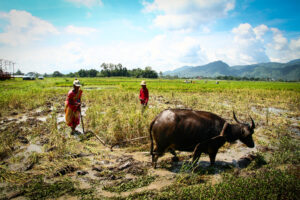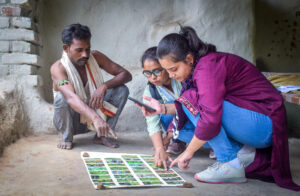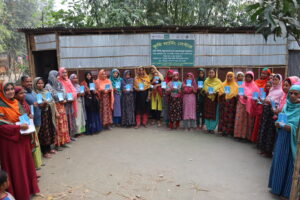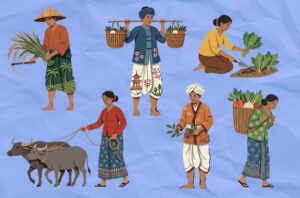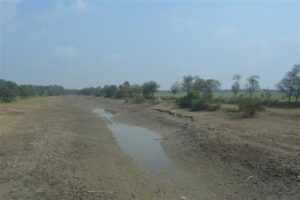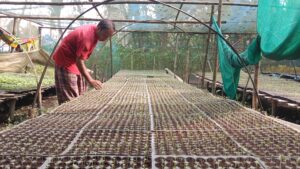by Rehana Noor
In the Haor wetlands of Bangladesh, rice is a key source of food and livelihood for millions of people. Working with partners, IRRI is helping advance rice cultivation in the region while protecting these threatened ecosystems through sustainable farming innovations.
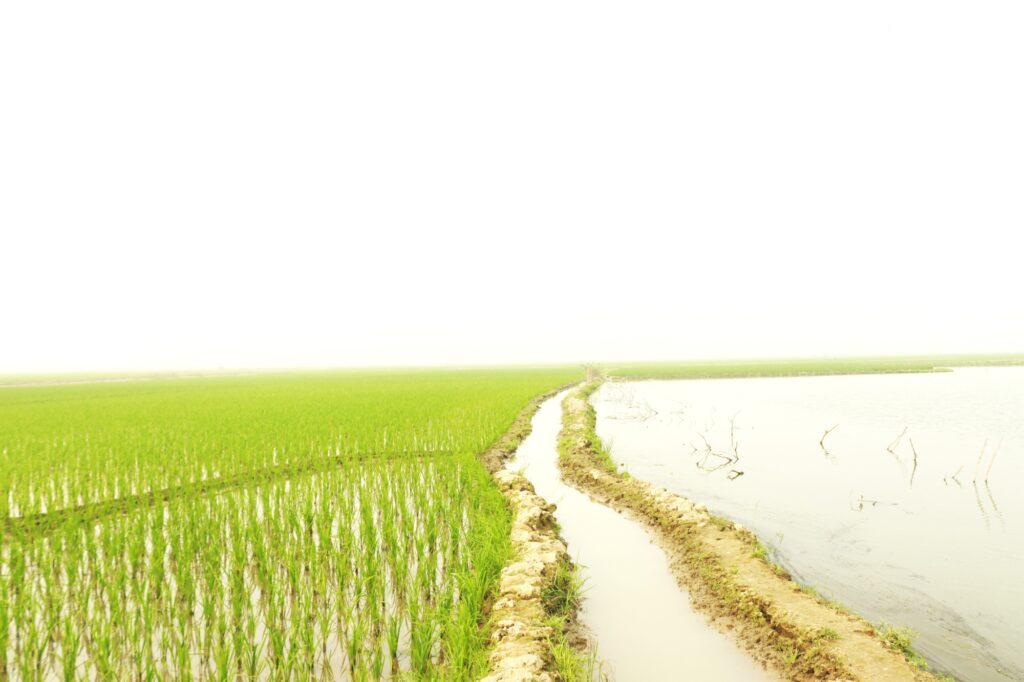
The haor wetland region of Bangladesh accounts for 25% of Bangladesh’s boro rice production and 15% of the country’s annual rice output (BBS, 2023), with single boro rice cultivated in 80% of the haor basin. However, the rice value chain in the haor region faces several challenges, including limited access to improved varieties and quality seeds and issues related to irrigation, mechanization, storage, labor shortages, and market access. These obstacles often result in delays in harvesting and significant losses for farmers.
Wetlands, permanently or seasonally saturated or flooded with water, provide vital ecosystem services, including wetland fisheries, agriculture, irrigation, and protection against floods. Most importantly, wetlands serve as a source of fresh water. Millions of people depend on wetlands, making them an essential economic lifeline.
The Global Assessment Report on Biodiversity and Ecosystem Services, produced by the Intergovernmental Science-Policy Platform on Biodiversity and Ecosystem Services (IPBES), identifies wetlands as the most threatened ecosystem, affecting 40% of the world’s plant and animal species that live or breed in these areas. Unfortunately, wetlands are disappearing at an alarming rate due to human activities and climate change, vanishing three times faster than natural forests. According to the World Heritage and Ramsar Conventions, 64% of the world’s wetlands have been lost since the early 20th century.
Wetlands as natural buffers against extreme weather
Wetlands act as natural buffers against floods, droughts, cyclones, and other extreme weather events. Since 1997, the Ramsar Convention Secretariat and the International Union for Conservation of Nature, both based in Gland, Switzerland, have promoted a special day to raise global awareness about the value of wetlands.
The Ramsar Convention identifies five types of wetlands that help nations cope with extreme weather events. For instance, every kilometer of mangrove forest can reduce storm surges by 50 cm, lessening the impact of cyclones and tsunamis. Coral reefs serve as offshore wave barriers, while well-managed rivers and floodplains can act as reservoirs during flash floods, mitigating damage downstream. Inland deltas provide a natural safeguard against drought, and peatlands store more than twice as much carbon as all the world’s forests combined, helping to mitigate the effects of climate change.
Wetlands in Bangladesh: a vital ecosystem
Wetlands are particularly important for a country like Bangladesh, which boasts a rich diversity of these ecosystems. Nearly half of Bangladesh’s land area—approximately 7-8 million hectares—consists of wetlands, largely due to its location in the Ganges-Brahmaputra-Meghna Basin, the largest delta in the world. It is no surprise that a significant portion of the Bangladeshi population relies heavily on these vital ecosystems. Recognizing their importance, Bangladesh joined the Ramsar Convention in 1992, following its establishment in 1975.
The Department of Bangladesh Haor and Wetland Development (DMHWD) has classified 30 types of permanent and temporary wetlands in the country, assigning them to four categories: marine or coastal, inland, human-made, and reversible. This classification includes the coastal belt, coral reefs at St. Martin’s Island, estuaries, mangroves in the Sundarbans, permanent river flows, peat swamps in Satkhira, Khulna, and Gopalganj, as well as reservoirs, baors, haors, hilly streams, canals, and lowlands. The government of Bangladesh has designated three wetlands as Ramsar sites: Tanguar Haor, Hakaluki Haor, and the Sundarbans.
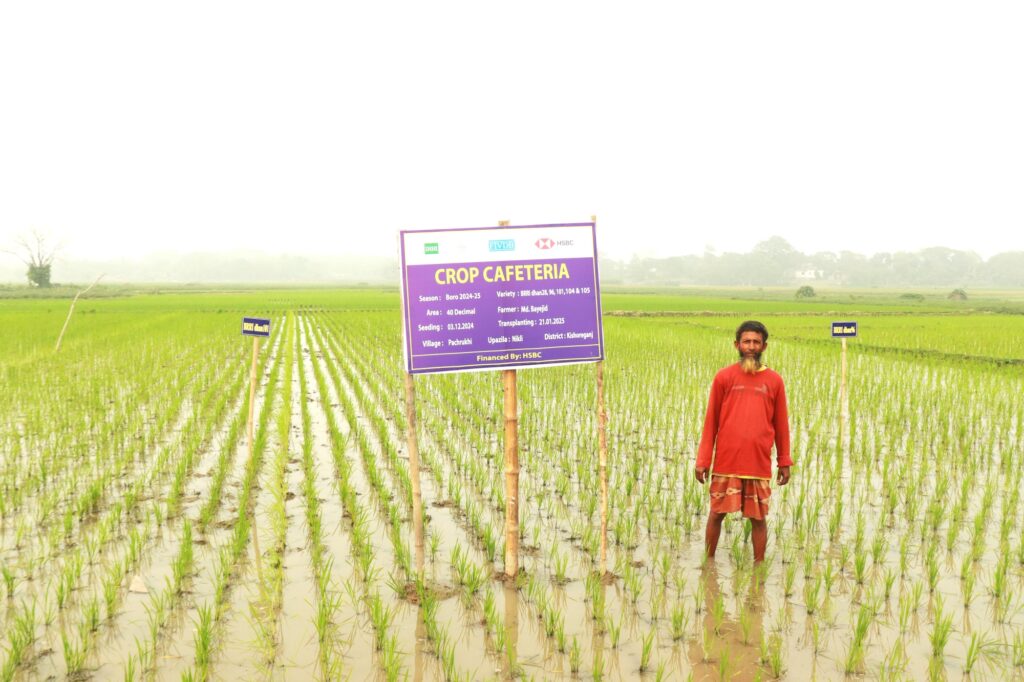
The Haor wetlands and rice cultivation
Rice is the primary crop in the haor ecosystem, with single-boro rice cultivated in 80% of the haor basin. This region accounts for 25% of Bangladesh’s boro rice production and 15% of the country’s annual rice output (BBS, 2023). However, the rice value chain in the Haor region faces several challenges, including limited access to improved varieties and quality seeds, as well as issues related to irrigation, mechanization, storage, labor shortages, and market access. These obstacles often result in delays in harvesting and significant losses for farmers.
Additionally, farmers struggle with the timely availability of quality seeds, poor crop management practices, and a lack of knowledge about modern techniques. The prevalence of older rice varieties increases the risk of genetic deterioration and heightens the likelihood of severe crop failures due to biotic and abiotic stresses. The negative impacts of extreme climatic events, such as rising temperatures and frequent flash floods, exacerbate these challenges.
IRRI’s contribution to sustainable rice cultivation in the region
The International Rice Research Institute (IRRI) is implementing a project financed by the Hong Kong and Shanghai Banking Corporation (HSBC) in Bangladesh to build a climate-smart rice value chain and enhance food security, nutrition, and livelihoods. The project’s objectives include increasing rice productivity, enhancing mechanization, improving post-harvest processing, and strengthening the capacities of value chain actors. It aims to directly benefit 3,000 farmers and indirectly support an additional 10,000 farmers.
Another project, funded by the Krishi Gobeshona Foundation (KGF), aims to develop and promote rice varieties that exhibit cold tolerance during the seedling and reproductive stages, along with high yields and shorter growth duration during the boro season. The expected outcomes include at least two promising rice lines, 30,000 breeding lines, product profiles of rice varieties, data and evidence regarding livelihoods and market systems in the haor areas, and generated evidence for rice breeding.
Protecting wetlands for a sustainable future
This year, the theme of International Wetland Day is “Protecting the Wetlands for Our Common Future.” Through innovations in sustainable rice-based farming and breeding in the haor ecosystem, IRRI contributes to a future that harmonizes with nature, ensuring the ecological, economic, and cultural benefits of this ecosystem for generations to come.

